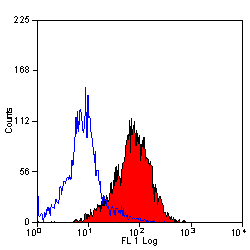CD49d antibody | PS/2




Rat anti Mouse CD49d
- Product Type
- Monoclonal Antibody
- Clone
- PS/2
- Isotype
- IgG2b
- Specificity
- CD49d
| Rat anti Mouse CD49d monoclonal antibody, clone PS/2 recognizes murine alpha 4 integrin (CD49d), a ~150 kDa single pass type I membrane glycoprotein that can associate with either beta 1 integrin (CD29) or beta 7 integrin to form heterodimers CD49d/CD29 (VLA-4) and alpha4/beta7 (LPAM-1) respectively (Holzmann et al. 1989). CD49d is expressed on most lymphocytes, granulocytes, monocytes and thymocytes. The primary ligands for CD49d are CD106 (VCAM-1), fibronectin and MAdCAM-1 (Sheppard et al. 1994). Clone PS/2 has also been reported to block the binding of CD49d to its ligands (Andrew et al. 1994). |
- Target Species
- Mouse
- Species Cross-Reactivity
-
Target Species Cross Reactivity Human - N.B. Antibody reactivity and working conditions may vary between species.
- Product Form
- Purified IgG - liquid
- Preparation
- Purified IgG prepared by affinity chromatography on Protein G from tissue culture supernatant
- Buffer Solution
- Phosphate buffered saline
- Preservative Stabilisers
- 0.09% sodium azide (NaN3)
- Carrier Free
- Yes
- Immunogen
- P815 DBA/2 murine mastocytoma cells.
- Approx. Protein Concentrations
- IgG concentration 1.0 mg/ml
- Fusion Partners
- Spleen cells from immunized Fisher rats were fused with SP2/0 mouse myeloma cells
- Regulatory
- For research purposes only
- Guarantee
- 12 months from date of despatch
Avoid repeated freezing and thawing as this may denature the antibody. Storage in frost-free freezers is not recommended.
| Application Name | Verified | Min Dilution | Max Dilution |
|---|---|---|---|
| Flow Cytometry | 1/50 | 1/100 | |
| Immunohistology - Frozen | |||
| Immunoprecipitation |
- Flow Cytometry
- Use 10μl of the suggested working dilution to label 106 cells in 100μl
References for CD49d antibody
-
Miyake, K. et al. (1991) Evidence for a role of the integrin VLA-4 in lympho-hemopoiesis.
J Exp Med. 173 (3): 599-607. -
Miyake, K. et al. (1991) A VCAM-like adhesion molecule on murine bone marrow stromal cells mediates binding of lymphocyte precursors in culture.
J Cell Biol. 114 (3): 557-65. -
Andrew, D.P. et al. (1994) Distinct but overlapping epitopes are involved in alpha 4 beta 7-mediated adhesion to vascular cell adhesion molecule-1, mucosal addressin-1, fibronectin, and lymphocyte aggregation.
J Immunol. 153 (9): 3847-61. -
Tchilian, E.Z. et al. (1997) Anti-alpha 4 integrin antibody induces apoptosis in murine thymocytes and staphylococcal enterotoxin B-activated lymph node T cells.
Immunology. 92: 321-7. -
Enghofer, M. et al. (1998) Lymphocyte transfer in streptozotocin-induced diabetes: adhesion of donor cells to islet endothelium.
Am J Physiol. 274: E928-35. -
Liu, Z.J. et al. (1999) A novel role for H-Ras in the regulation of very late antigen-4 integrin and VCAM-1 via c-Myc-dependent and -independent mechanisms.
J Immunol. 163: 4901-8. -
Tanneau, G.M. et al. (1999) Differential recruitment of T- and IgA B-lymphocytes in the developing mammary gland in relation to homing receptors and vascular addressins.
J Histochem Cytochem. 47: 1581-92. -
Fukuoka, M. et al. (2000) Antiadhesive function of 130-kd glycoform of CD43 expressed in CD4 T-lymphocyte clones and transfectant cell lines.
Blood. 96: 4267-75.
View The Latest Product References
-
Hokibara, S. et al. (2000) Effects of monoclonal antibodies to adhesion molecules on eosinophilic myocarditis in Toxocara canis-infected CBA/J mice.
Clin Exp Immunol. 114: 236-44. -
Bowden, R.A. et al. (2002) Role of alpha4 integrin and VCAM-1 in CD18-independent neutrophil migration across mouse cardiac endothelium.
Circ Res. 90: 562-9. -
Hirata, T. et al. (2002) P-, E-, and L-selectin mediate migration of activated CD8+ T lymphocytes into inflamed skin.
J Immunol. 169: 4307-13. -
Maus, U.A. et al. (2004) Pneumolysin-induced lung injury is independent of leukocyte trafficking into the alveolar space.
J Immunol. 173: 1307-12. -
Ferrer, P. et al. (2005) Association between pterostilbene and quercetin inhibits metastatic activity of B16 melanoma.
Neoplasia. 7: 37-47. -
Eshghi, S. et al. (2007) Alpha4beta1 integrin and erythropoietin mediate temporally distinct steps in erythropoiesis: integrins in red cell development.
J Cell Biol. 177: 871-80. -
Vaz, R. et al. (2012) Fibronectin promotes migration, alignment and fusion in an in vitro myoblast cell model.
Cell Tissue Res. 348: 569-78. -
Zhang, Y. et al. (2012) Autotaxin through lysophosphatidic acid stimulates polarization, motility, and transendothelial migration of naive T cells.
J Immunol. 189: 3914-24. -
Gillberg, L. et al. (2013) Effective treatment of mouse experimental colitis by alpha 2 integrin antibody: comparison with alpha 4 antibody and conventional therapy.
Acta Physiol (Oxf). 207: 326-36. -
Omenetti, S. et al. (2015) Dysregulated intrahepatic CD4+ T-cell activation drives liver inflammation in ileitis-prone SAMP1/YitFc mice.
Cell Mol Gastroenterol Hepatol. 1 (4): 406-19. -
Chung, K.J. et al. (2017) A self-sustained loop of inflammation-driven inhibition of beige adipogenesis in obesity.
Nat Immunol. 18 (6): 654-64. -
Andrews, S.L. et al. (2023) SVEP1 influences monocyte to macrophage differentiation via integrin α4β1/α9β1 and Rho/Rac signalling.
Biochim Biophys Acta Mol Cell Res. 1870 (6): 119479.
- Synonyms
- Integrin Alpha 4 Chain
- VLA-4
- RRID
- AB_566802
- UniProt
- Q00651
- Entrez Gene
- Itga4
- GO Terms
- GO:0007157 heterophilic cell-cell adhesion
- GO:0001968 fibronectin binding
- GO:0001974 blood vessel remodeling
- GO:0004872 receptor activity
- GO:0008305 integrin complex
- GO:0007159 leukocyte cell-cell adhesion
- GO:0007229 integrin-mediated signaling pathway
- GO:0007507 heart development
- GO:0009897 external side of plasma membrane
- View More GO Terms
- GO:0016477 cell migration
- GO:0060324 face development
- GO:0060710 chorio-allantoic fusion
MCA1230GA
If you cannot find the batch/lot you are looking for please contact our technical support team for assistance.
Please Note: All Products are "FOR RESEARCH PURPOSES ONLY"
View all Anti-Mouse ProductsAlways be the first to know.
When we launch new products and resources to help you achieve more in the lab.
Yes, sign me up


